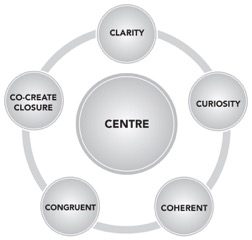5 Steps To Having Courageous Conversations

Team Dynamics
October 20, 2017
Julia Felton
Herd Leader Of Business HorsePower Ltd
According to the 2015 Employee Trends Report by Quantum Workplace, one of the biggest areas of concern for team members is that there is often not open and honest communication with managers. So why is this? Why does miscommunication pervade at least 50% of business conversations? Is technology to blame or are there some other dynamics at work.
In my experience, yes technology does have a part to play. Emails and text can be taken out of context and without any supporting body language to back up the conversation they can fuel anxiety and in some cases, escalate beyond repair, this is why face to face conversations are so much more effective.
And yet face to face conversations too can lead to miscommunication especially when the manager fails to lead the conversation or is fearful about discussing the subject. Take for example if a manager needs to have a difficult conversation with team members, say about their performance. If the manager is not feeling confident in having the conversation they might not articulate clearly the problem and so the team member leaves confused about what they have done wrong. This then causes the situation to escalate and before long both parties become frustrated. I call these conversations Courageous Conversations as they require the manager to be ruthlessly honest and transparent, often saying things that no-one has said in the past.
Having a clear framework for navigating these Courageous Conversations is essential to help managers approach the situation with confidence and certainty. This is why I developed the 6 C’s to Successful Courageous Conversations Framework.

Throughout any Courageous Conversation, it is imperative that you manage your emotional energy. If as the leader of the conversation you are grounded and in the moment it will help the person you are talking to remain in this state too. Make sure you breathe deeply, stay calm and stay centered in your energy. Notice if you go off track and re-calibrate if necessary.
Step One: Clarity
Be clear on the reason for the conversation and the desired outcome. Most courageous conversations falter because there is a lack of clarity about the real issue. Get to the root cause of the problem and address this rather than focusing on the symptoms
Step Two: Curiosity
Cultivate an attitude of discovery and curiosity. Pretend you don’t know anything and learn as much as you can about the other person’s point of view. Watch their body language and listen to what they are not saying as well as what they are saying. Don’t interrupt, unless to clarify, and let the person talk until they are finished.
Step Three: Coherent
Make sure that you have heard and understood everything that has been said by repeating back to them what they said. This will ensure the team member feels that they have been listened to
Step Four: Congruent
When the team member has said everything, then share with them how you see things from your perspective. Help them see your position without undermining their own. Seek clarity on how the team member came to that conclusion and how it differs from your own stance.
Step Five: Co-Create Closure
Now you both understand each other’s point of view it’s time to co-create a solution. Brainstorm and come up with ideas that you both think might work. Find something the team member says that resonates with the solution you desire and build on this. If the conversation at any time becomes adversarial go back to inquiry and further clarification on their point of view. The more the team member feels listened to the more they will engage in co-creating a solution with you.
Remember, that for any situation you encounter there are always multiple perspectives, so be empathetic of the other person. Always be curious about how they see the situation and be aware of how your own judgments and prejudice may be impacting what you are observing. When you appreciate, that others have a different perspective from you and you can start to see things through their eyes, you are able to make more informed decisions, and in doing so increase team member engagement.








This is a very useful article. I discovered that Courage was not the shortfall of dread, but rather the victory over it. The valiant man isn’t he who doesn’t feel apprehensive, however, he who vanquishes that fear. You can also check out my blog on Tips on How to Become More Courageous
Regards
Attilio